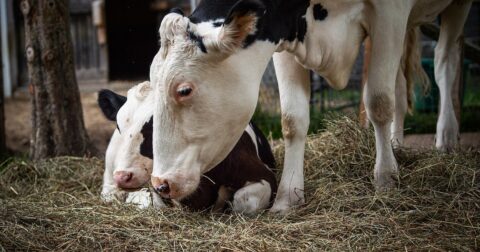Perspective
Critics Declared Veganism Dead in 2025. Here’s What Those Obituaries Are Missing.
Food•5 min read
Perspective
Consumers are becoming increasingly aware of the inherent cruelty behind dairy farming, but farmers are quick to come to its defense.

Perspective • Food • Industry

Words by Jessica Scott-Reid
Many long-hidden truths about dairy farming have in recent years been revealed. It is now relatively common knowledge that cows do not just naturally make milk, but must be impregnated and give birth in order for lactation to occur, and that calves must be routinely removed in order for that milk to be rerouted for human consumption.
These revelations, along with others regarding health concerns associated with dairy consumption and environmental impacts of dairy farming, have all played part in the dramatic rise in plant-based milk consumption over the last decade. As a result of this market change, dairy marketing has doubled down on its message, attempting to quell consumer qualms by taking them on, addressing, skirting, or even downplaying our worries about what life is really like for dairy cows.
“Our cows are our dairy queens,” reads the Dairy Farmers of Canada (DFC) website, “so we make sure they’re always comfortable and well cared for. From barns and bedding to brushes and hoof care, discover the many ways Canadian dairy farmers give their cows the royal treatment.”
On Twitter, dairy farmers are quick to defend standard practices such as cow-calf separation:
For caring consumers, these claims can cause confusion. Are cows actually bad mothers who don’t care when their babies are taken away? Do calves benefit from being removed from them? Do those big round brushes make dairy cows happy? Is the dairy industry actually treating these animals well? I asked a neuroscientist and expert in animal behavior and intelligence to help set the record straight.
Dr. Lori Marino is the co-author of a landmark review published in the journal Animal Behavior and Cognition, along with Kristin Allen, called “The Psychology of Cows.” The essay provides detailed analyses of all data and research available in empirical and review papers in peer-reviewed professional journals, as well as in books, book chapters, theses, and dissertations. What the researchers found was that cows are far more emotional, intelligent, and social than usual food-systems-based conversations portray them to be. (A great discussion of the research can be found here, from Psychology Today.)
Marino, a veteran expert in the field, says even she was “stunned” by all she learned in creating the review. “There is a lot more social complexity than it looks like when we see a bunch of cows standing in field—it’s not just a bunch of cows standing in a field.”
Marino says cows have intricate social structures. “They have friends, they have relationships.” They are not “simple”—a word so often used to describe them. And when their babies are removed from them soon after birth, they absolutely care. Undercover footage obtained by Canadian animal law organization Animal Justice from a dairy farm in BC and broadcasted in part on CTV news last year shows over and over mother cows in distress as their babies are hauled away (along with footage of workers violently beating cows). Mothers chase after their babies and express vocalizations. These sounds, says Marino, “are not just some involuntary noises. They actually represent emotional states … they don’t bellow all the time; they bellow when something happens that upsets them.”
As for the calves, they too can show signs of stress upon removal after birth. “They show foot-stomping, they pace back and forth, they may urinate,” Marino explains, “They show signs of psychological and emotional distress.” And this makes sense, she adds, because “when cows are born they can walk around on their own, so they have come into the world to quickly learn who’s mom and to follow her around. They are going to be very aware of when something comes between them and their mother.”
As for the common argument that cows are bad mothers, Marino scoffs, stating that “if cows were bad mothers they wouldn’t have evolved; there would be no cows.” Rather, she says, “Cows care very much for their children, they are very bonded.”
Most dairy marketing, however, shies away from the separation situation, preferring instead to highlight all the “good” things dairy cows are provided, such as food, bedding, those big brushes, and “pedicures” as DFC describes proper hoof care. But as Marino points out, these things are “a very tiny part of their experience on factory farms … they don’t speak at all to the real problem, which is living under those conditions with no control over their own lives.” Highlighting such things, she says, is more about making people feel better than the animals.
Focusing on the physical care of cows under the umbrella of welfare, while glossing over emotional care appears to be a diversion tactic commonly used in dairy marketing. Providing food, water, and very basic maintenance, says Marino, is the bare minimum: “Just enough to keep them alive and reproducing, so they can perpetuate the practice. It has very little to do with the experience of the individual animals.”
Caring for cows should not only involve their physical well-being, Marino says, “There’s social comfort, emotional comfort. There is a mind there.” And where that mind and those social and emotional complexities can really be seen, Marino explains emphatically, is at animal sanctuaries, where animals live out their lives free from exploitation, harm, and slaughter. “You see them actually playing, actually relaxing,” she says. “You see them becoming real cows.” On a factory farm, she adds, that’s just not possible. “You can add bells and whistles, but in the end, it’s so far from what they need to thrive.” She says, “It’s just not possible.”